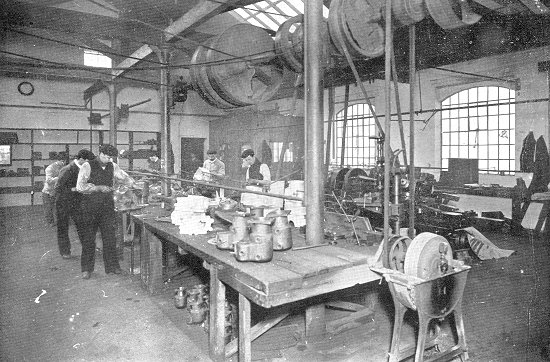|
One of
the pioneers of the motor industry
It was the invention of the
petrol motor that made possible the running, on
all the roads of the world, of the
self-propelled vehicle or automobile; and it is,
possibly, with the help of the petrol motor that
the conquest of the air will be achieved. The
making of these motors was in England a few
years ago an unknown industry. When the
automobile was first taken up in this country;
in other words, when a perverse government at
length allowed it to be taken up; foreigners had
gained an immense start in the perfecting of
this engine, and we were dependent upon them for
those we required. Yet the development of the
industry in England has made such immense
strides that it has caught up with and even,
possibly, temporarily over-run the phenomenally
increased demand for the article.

The main shop.
Wolverhampton was not
behind in this new field of industry, and the
first among the firms devoting their energies to
this new branch of manufacture was that now
known as the Stevens Motor Manufacturing Company
Limited, now occupying premises in the west end
of the town at the corner of Pelham Street and
Kimberley Street, and running through to
Merridale Street. The front building contains
upstairs the general and private offices, while
below are extensive stores for finished parts
and fittings, the parts being, where possible,
standardised and interchangeable. Beyond is the
extensive and convenient workshop, with overhead
driving shafts operating the various and usual
engineering tools and machines, among which is
noticeable No. 16 turret lathe by Alfred Herbert
Ltd., the revolving turret being fitted with all
the tools used consecutively on a given complex
piece of work; other lathes, milling, slotting,
drilling and boring machines are there, in fact,
all the necessary adjuncts to an up-to-date and
fully-equipped engineering shop. The power is
derived from a
National Gas Engine in an
engine room beyond, while the oil stores, the
stock-room for the rough castings of iron,
aluminium and other metals, and the testing room
where every engine is brake-tested before going
out, form other departments conveniently opening
out into the main workshop. From 50 to 80 men
are employed, and there is room for more, while
land on two sides will allow for extension when
necessary. The buildings at present cover an
area of 2260 yards and the land on which they
stand is freehold.

A corner of the main shop.
The general run of motors
made by the firm are from single cylinder
bicycle motors to 2-cylinder engines for Cars,
boats, trolleys, etc. A number of 8 to 10hp.
4-cylinder engines were under construction at
the time of our visit. A large part of the
firm's trade is with the colonies, their motors
being recognised as durable and dependable.
One 4-cylinder 16 to 18hp.
motor had just been shipped for use on a launch
on the Nile, while many are fitted to the
trolleys used by railway inspectors in India and
South America.
The Stevens Motor
Manufacturing Co. are now making a portable
petrol engine of special design capable of being
used for manifold purposes such as driving
pumps, dynamos, or other machines, including all
kinds of farmers’ machinery, where they would be
invaluable for working all manner of cutting and
grinding machines. In respect to the firm's work
in adapting the petrol motor to various uses, it
may be said that they have built special engines
for aeroplanes and dirigible balloons, one, the
largest petrol engine turned out in
Wolverhampton, being an 8-cylinder V type motor
for a dirigible balloon. This engine, fitted
with a loose copper water jacket and overhead
valves, though of 120hp., only weighed 500 lbs.
It may be said that now the
general stagnation in the motor trade has passed
away, this firm's prospects are exceedingly
bright, not only for their standard motors for
cycles and carrs, but in view of the development
of the portable engine type and possibly also
the light engine for air machines. The works
offer every facility for the building of
chassis, etc., and, as we have said, are capable
of extension. |

